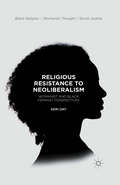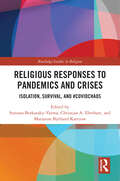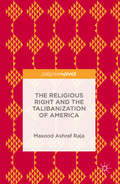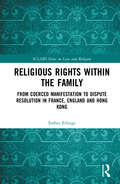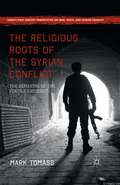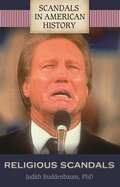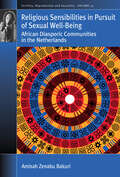- Table View
- List View
Religious Renewal in France, 1789-1870: The Roman Catholic Church between Catastrophe and Triumph
by Roger PriceThis book provides a study of the manner in which the Roman Catholic Church in France responded to successive revolutions between 1789 and 1870 as well as to the cultural upheaval associated with accelerating socio-economic change. It focuses on the Church as an institution engaged in a dynamic process of (re)Christianization and determined, as the only repository of the true faith of Jesus Christ, to fortify belief , and to combat the ‘Satanic’ forces of moral corruption and revolutionary chaos and create a ‘counter society’, the société parfaite. Discussion of the Church as an institution in crisis, of the recruitment, instruction and mind-sets of its bishops, parish clergy, and the members of religious orders, of its hierarchical structures and internal discipline, and of the need to compensate for the losses suffered during a period of revolutionary upheaval, provides the basis for an exploration of its evolving doctrine(s) and sense of purpose; for an assessment of the pastoral care provided to parish communities; and of the leadership and moral qualities of the clergy; before final consideration of the reception of the religious message(s).
Religious Renewal in France, 1789-1870: The Roman Catholic Church between Catastrophe and Triumph
by Roger PriceThis book provides a study of the manner in which the Roman Catholic Church in France responded to successive revolutions between 1789 and 1870 as well as to the cultural upheaval associated with accelerating socio-economic change. It focuses on the Church as an institution engaged in a dynamic process of (re)Christianization and determined, as the only repository of the true faith of Jesus Christ, to fortify belief , and to combat the ‘Satanic’ forces of moral corruption and revolutionary chaos and create a ‘counter society’, the société parfaite. Discussion of the Church as an institution in crisis, of the recruitment, instruction and mind-sets of its bishops, parish clergy, and the members of religious orders, of its hierarchical structures and internal discipline, and of the need to compensate for the losses suffered during a period of revolutionary upheaval, provides the basis for an exploration of its evolving doctrine(s) and sense of purpose; for an assessment of the pastoral care provided to parish communities; and of the leadership and moral qualities of the clergy; before final consideration of the reception of the religious message(s).
Religious Representation in Place: Exploring Meaningful Spaces at the Intersection of the Humanities and Sciences (Religion and Spatial Studies)
by Mark K. George Daria Pezzoli-OlgiatiReligious Representation in Place brings together an interdisciplinary group of scholars from the Humanities and Sciences to broaden the understanding of how religious symbols and spatial studies interact. The essays consider the relevance of religion in the experience of space, a fundamental dimension of culture and human life.
Religious Resistance to Neoliberalism: Womanist and Black Feminist Perspectives (Black Religion/Womanist Thought/Social Justice)
by Keri DayReligious Resistance to Neoliberalism offers compelling and intersectional religious critiques of neoliberalism. Neoliberalism is the normative rationality of contemporary global capitalism that orders people to live by the generalized principle of competition in all social spheres of life. Keri Day asserts that neoliberalism and its moral orientations consequently breed radical distrust, lovelessness, disconnection, and alienation within society. She argues that engaging black feminist and womanist religious perspectives with Jewish and Christian discourses offers more robust critiques of a neoliberal economy. Employing womanist and black feminist religious perspectives, this book provides six theoretical, theologically constructive arguments to challenge the moral fragmentation associated with global markets. It strives to envision a pragmatic politics of hope.
Religious Responses to Marriage Equality (Routledge Studies in Religion and Politics)
by Luke E PerryThe Supreme Court ruling in Obergefell v. Hodges (2015) ended a 20-year political battle over same-sex marriage in the USA. The ruling in favor of a constitutional right for gays and lesbians to marry reflected growing social acceptance and political rights for gays and lesbians. At the same time, America remains a deeply religious country and many religious organizations have long opposed same-sex marriage. How do religious organizations interpret, process, and respond to shifting attitudes and public policy toward the LGBT community? Examining how religious groups in America have responded theologically and politically to the legalization of same-sex marriage, the book provides case studies from across the American religious spectrum to explore how each group understands same-sex marriage and has reacted theologically, socially, and politically to its new standing as a constitutional right. Each case study focuses on formal statements made by church leaders, incorporates original data gathered from interviews with regional and local religious authorities, and analyzes existing polling data of adherents at large. Offering a comprehensive examination of religious responses to marriage equality in the USA, this book will interest scholars and students in the fields of religion and politics, civil rights, social change, and public policy.
Religious Responses to Marriage Equality (Routledge Studies in Religion and Politics)
by Luke E PerryThe Supreme Court ruling in Obergefell v. Hodges (2015) ended a 20-year political battle over same-sex marriage in the USA. The ruling in favor of a constitutional right for gays and lesbians to marry reflected growing social acceptance and political rights for gays and lesbians. At the same time, America remains a deeply religious country and many religious organizations have long opposed same-sex marriage. How do religious organizations interpret, process, and respond to shifting attitudes and public policy toward the LGBT community? Examining how religious groups in America have responded theologically and politically to the legalization of same-sex marriage, the book provides case studies from across the American religious spectrum to explore how each group understands same-sex marriage and has reacted theologically, socially, and politically to its new standing as a constitutional right. Each case study focuses on formal statements made by church leaders, incorporates original data gathered from interviews with regional and local religious authorities, and analyzes existing polling data of adherents at large. Offering a comprehensive examination of religious responses to marriage equality in the USA, this book will interest scholars and students in the fields of religion and politics, civil rights, social change, and public policy.
Religious Responses to Pandemics and Crises: Isolation, Survival, and #Covidchaos (Routledge Studies in Religion)
by Sravana Borkataky-Varma Christian A. Eberhart Marianne Bjelland KartzowReligious Responses to Pandemics and Crises explores various dimensions of the interrelations between the individual, community, and religion. With their global scope, the contributions to this volume represent reflections on the rich and multifaceted spectrum of human responses in a variety of different religions and cultures to the current SARS-2-COVID-19 pandemic and similar crises in the past.The contributions are organized in three thematic parts focusing on strategies, rituals, and past and present responses to pandemics and crises. They reflect on the intersection of personal or communal responses and state-mandated policies relative to SARS-2-COVID-19 while outlining different strategies to cope with the pandemic crisis. Timely questions explored include: How do individuals connect with or disconnect from religious and spiritual communities during times of personal and collective crises, including pandemics? How do religious practices such as rituals bridge individuals and communities? How do religious texts from past and present highlight and represent crises and pandemics? Dynamic and multidisciplinary in its inquiry, this volume is an outstanding resource for scholars of religion, theology, anthropology, social sciences, ritual theory, sex and gender studies, and contemporary medical science.
Religious Responses to Pandemics and Crises: Isolation, Survival, and #Covidchaos (Routledge Studies in Religion)
Religious Responses to Pandemics and Crises explores various dimensions of the interrelations between the individual, community, and religion. With their global scope, the contributions to this volume represent reflections on the rich and multifaceted spectrum of human responses in a variety of different religions and cultures to the current SARS-2-COVID-19 pandemic and similar crises in the past.The contributions are organized in three thematic parts focusing on strategies, rituals, and past and present responses to pandemics and crises. They reflect on the intersection of personal or communal responses and state-mandated policies relative to SARS-2-COVID-19 while outlining different strategies to cope with the pandemic crisis. Timely questions explored include: How do individuals connect with or disconnect from religious and spiritual communities during times of personal and collective crises, including pandemics? How do religious practices such as rituals bridge individuals and communities? How do religious texts from past and present highlight and represent crises and pandemics? Dynamic and multidisciplinary in its inquiry, this volume is an outstanding resource for scholars of religion, theology, anthropology, social sciences, ritual theory, sex and gender studies, and contemporary medical science.
Religious Responses to Political Crises in Jewish and Christian Tradition (The Library of Hebrew Bible/Old Testament Studies)
by Yair Hoffman Henning Graf ReventlowThis book continues a series of volumes containing the papers read at an annual conference held in turn by Tel Aviv and Bochum in the course of a co-operation between the Lester and Sally Entin Faculty of Humanities, Chaim Rosenberg School of Jewish Studies, the Department of Bible of Tel Aviv University and the Faculty of Protestant Theology in the University of the Ruhr, Bochum, since 1985. As a collection the book focuses on the important role religious views have played in critical moments during Jewish and Christian history. It argues for the significance that the role religious beliefs play in political and economic decision-making and the formation of worldviews; as well as demonstrating common convictions held by both Jewish and Christians that can be used as a foundation to find similar answers to actual problems.Focusing on the conference held in March 2005 at Tel Aviv, the book contains a collected biography of the literature quoted as well as a list of standard abbreviations.
Religious Revelation (Palgrave Frontiers in Philosophy of Religion)
by James KellenbergerThis book addresses several dimensions of religious revelation. These include its occurrence in various religious traditions, its different forms, its elaborations, how it has been understood by Western theologians, and differing views of revelation’s ontological status. It has been remarked that revelation is most at home in theistic traditions, and this book gives each of the three Abrahamic traditions – Judaism, Christianity, and Islam – its own chapter. Revelation, however, is not limited to theistic traditions; forms found in Buddhism and nondevotional (nontheistic) Hinduism are also explored. In the book’s final chapter a particularly significant form of religious revelation is identified and examined: pervasive revelation. The theistic manifestation of this form of revelation, pervasive in the sense that it may occurs in all the domains or dimensions of human existence, is shown to be richly represented in the Psalms, where God’s presence may be found in the heavens, in the growing of grass, and in one’s daily going out and coming in. Pervasive revelation of religious reality is also shown to be present in the Buddhist tradition.
Religious Rhetoric in US Right-Wing Politics: Donald Trump, Intergroup Threat, and Nationalism (Palgrave Studies in Religion, Politics, and Policy)
by Chiara M. MiglioriThis book seeks to understand white conservative Christians’ support for Donald Trump, using their own words. Drawing on the triangular relationship between the 45th president, and his voters, and religious organizations, this work investigates the creation of the tale of Trump as the protector and enhancer of Christian values. The first part of the book discusses in detail the white conservative Christian constituency in the United States, and the development of feelings of displacement and resentment fostered by intergroup threat and nationalism. The central part focuses on the actor known as the “Religious Right,” through the rhetoric of one of their most representative organizations in the twenty-first century. The final part focuses on the character of Donald Trump and his peculiar relationship with religious discourse. The book demonstrates that while such discourse is expected of Trump as a Republican candidate, his approach to it is characterized by detachment and sloganized exploitation of Christian symbols. Ultimately, the book highlights the cultural tools that are crucial in the reproduction of structures of inequality and the ways they have been used by conservative politicians and groups to accumulate power.
The Religious Right and the Talibanization of America
by Masood Ashraf RajaThis highly original book suggests that the practices of Taliban and the American far right, two very significant and poorly understood groups, share common features. This commonality can be found in the philosophical basis of their ideological beliefs, in their comparative worldviews, and in their political practices. As Raja argues, the Taliban are much less the product of an irrational fundamentalism, and the radical right in America is much more the result of such a mindset, than Americans recognize. After providing a detailed explanation of his theoretical concepts and specialized vocabulary, the author develops a discussion of the subject in this brief but penetrating book. This is a book that should attract a wide readership among both academics and the general public.
Religious Rights within the Family: From Coerced Manifestation to Dispute Resolution in France, England and Hong Kong (ICLARS Series on Law and Religion)
by Esther ErlingsIt is often asserted that ‘A family that prays together, stays together’. But what if a child no longer wishes to pray? This book analyses the law in relation to situations where parents force their children to manifest the parental religion. From thorough examination of international law it argues that, unlike what is generally believed, the human rights regime does not grant parents a right to impose manifestations of their religion on their children. Instead, the author proposes to regard coerced manifestations as a limitation on children’s right to freedom of manifestation, based on national laws that give parents rights at the domestic level under principles such as parental responsibility. The book focuses on two aspects of States’ positive obligations in this regard. First, the obligation to provide a regulatory framework that can protect children’s right to freedom of manifestation, and restricts limitations to those that are proportionate or 'necessary in a democratic society'. Second, to provide access to remedies, which it is argued should consist of access to a family-friendly infrastructure for dispute resolution available to parents and children in conflict over religious manifestation. Both depend heavily on the way States balance power between parents and children at the national level. The book includes three case studies and social research of jurisdictions that offer different perspectives under the principles of parental authority (France), parental responsibility (England) and parental rights (Hong Kong).
Religious Rights within the Family: From Coerced Manifestation to Dispute Resolution in France, England and Hong Kong (ICLARS Series on Law and Religion)
by Esther ErlingsIt is often asserted that ‘A family that prays together, stays together’. But what if a child no longer wishes to pray? This book analyses the law in relation to situations where parents force their children to manifest the parental religion. From thorough examination of international law it argues that, unlike what is generally believed, the human rights regime does not grant parents a right to impose manifestations of their religion on their children. Instead, the author proposes to regard coerced manifestations as a limitation on children’s right to freedom of manifestation, based on national laws that give parents rights at the domestic level under principles such as parental responsibility. The book focuses on two aspects of States’ positive obligations in this regard. First, the obligation to provide a regulatory framework that can protect children’s right to freedom of manifestation, and restricts limitations to those that are proportionate or 'necessary in a democratic society'. Second, to provide access to remedies, which it is argued should consist of access to a family-friendly infrastructure for dispute resolution available to parents and children in conflict over religious manifestation. Both depend heavily on the way States balance power between parents and children at the national level. The book includes three case studies and social research of jurisdictions that offer different perspectives under the principles of parental authority (France), parental responsibility (England) and parental rights (Hong Kong).
The Religious Roots of Contemporary European Identity
by Lucia Faltin Melanie J. WrightThis volume provides a coherent critical examination of current issues related to the religious roots of contemporary, i.e. post-1990 European identity, by analyzing the components of contemporary European identity, the presence of religion in the development of national identities, manifestation of religious roots in secular society, and the role of religion in further European integration and social inclusion. The book involves a multi and interdisciplinary approach to the theme, by bringing together scholars in history, religious studies, sociology, cultural studies, European studies, and international relations. This rigorously edited volume provides a coherent analysis of the religious roots of Europe's identity today, with particular attention to the secular context of religious communities. Europe is often perceived as secular by most of its citizens, regardless of their creed. Bearing this in mind, the authors build upon their expertise in different fields of arts and humanities to identify some of the key elements of European religious heritage and its manifestation in Europe's identity, be it secular or otherwise perceived. The authors also indicate the role these elements play in further European integration. With this focused approach, the publication identifies a number of similarities across faiths and, more holistically, vis-Á -vis Europe. This serves the readers to perceive their own identity in a wider context of shared values, reaching beyond a particular faith or non-religious framework.
The Religious Roots of the First Amendment: Dissenting Protestants and the Separation of Church and State
by Nicholas P. MillerTraditional understandings of the genesis of the separation of church and state rest on assumptions about "Enlightenment" and the republican ethos of citizenship. In The Religious Roots of the First Amendment, Nicholas P. Miller does not seek to dislodge that interpretation but to augment and enrich it by recovering its cultural and discursive religious contexts--specifically the discourse of Protestant dissent. He argues that commitments by certain dissenting Protestants to the right of private judgment in matters of Biblical interpretation, an outgrowth of the doctrine of the priesthood of all believers, helped promote religious disestablishment in the early modern West. This movement climaxed in the disestablishment of religion in the early American colonies and nation. Miller identifies a continuous strand of this religious thought from the Protestant Reformation, across Europe, through the English Reformation, Civil War, and Restoration, into the American colonies. He examines seven key thinkers who played a major role in the development of this religious trajectory as it came to fruition in American political and legal history: William Penn, John Locke, Elisha Williams, Isaac Backus, William Livingston, John Witherspoon, and James Madison. Miller shows that the separation of church and state can be read, most persuasively, as the triumph of a particular strand of Protestant nonconformity-that which stretched back to the Puritan separatist and the Restoration sects, rather than to those, like Presbyterians, who sought to replace the "wrong" church establishment with their own, "right" one. The Religious Roots of the First Amendment contributes powerfully to the current trend among some historians to rescue the eighteenth-century clergymen and religious controversialists from the enormous condescension of posterity.
The Religious Roots of the First Amendment: Dissenting Protestants and the Separation of Church and State
by Nicholas P. MillerTraditional understandings of the genesis of the separation of church and state rest on assumptions about "Enlightenment" and the republican ethos of citizenship. In The Religious Roots of the First Amendment, Nicholas P. Miller does not seek to dislodge that interpretation but to augment and enrich it by recovering its cultural and discursive religious contexts--specifically the discourse of Protestant dissent. He argues that commitments by certain dissenting Protestants to the right of private judgment in matters of Biblical interpretation, an outgrowth of the doctrine of the priesthood of all believers, helped promote religious disestablishment in the early modern West. This movement climaxed in the disestablishment of religion in the early American colonies and nation. Miller identifies a continuous strand of this religious thought from the Protestant Reformation, across Europe, through the English Reformation, Civil War, and Restoration, into the American colonies. He examines seven key thinkers who played a major role in the development of this religious trajectory as it came to fruition in American political and legal history: William Penn, John Locke, Elisha Williams, Isaac Backus, William Livingston, John Witherspoon, and James Madison. Miller shows that the separation of church and state can be read, most persuasively, as the triumph of a particular strand of Protestant nonconformity-that which stretched back to the Puritan separatist and the Restoration sects, rather than to those, like Presbyterians, who sought to replace the "wrong" church establishment with their own, "right" one. The Religious Roots of the First Amendment contributes powerfully to the current trend among some historians to rescue the eighteenth-century clergymen and religious controversialists from the enormous condescension of posterity.
The Religious Roots of the Syrian Conflict: The Remaking of the Fertile Crescent (Twenty-first Century Perspectives on War, Peace, and Human Conflict)
by Mark TomassExplores the historical origins of Syria's religious sects and their dominance of the Syrian social scene. It identifies their distinct beliefs and relates how the actions of the religious authorities and political entrepreneurs acting on behalf of their sects expose them to sectarian violence, culminating in the dissolution of the nation-state.
Religious Rules, State Law, and Normative Pluralism - A Comparative Overview (Ius Comparatum - Global Studies in Comparative Law #18)
by Rossella Bottoni Rinaldo Cristofori Silvio FerrariThis book is devoted to the study of the interplay between religious rules and State law. It explores how State recognition of religious rules can affect the degree of legal diversity that is available to citizens and why such recognition sometime results in more individual and collective freedom and sometime in a threat to equality of citizens before the law. The first part of the book contains a few contributions that place this discussion within the wider debate on legal pluralism. While State law and religious rules are two normative systems among many others, the specific characteristics of the latter are at the heart of tensions that emerge with increasing frequency in many countries. The second part is devoted to the analysis of about twenty national cases that provide an overview of the different tools and strategies that are employed to manage the relationship between State law and religious rules all over the world.
Religious Satire in the Era of New Atheism: Do You ‘Seriously Believe That’ After 9/11 (The Cultural Politics of Media and Popular Culture)
by Jerry C. JaffeReligious Satire in the Era of New Atheism presents a contemporary account of religious satire as evidenced by the modern art of stand-up comedy.Focused on the context of the post-9/11 American culture phenomenon, sometimes referred to as the New Atheism – as embodied by public intellectuals such as Christopher Hitchens, Sam Harris, and Richard Dawkins – it documents the rise of comedic satire in relation to evangelical beliefs and religious dogma. Drawing on the author’s own experience of stand-up performance, it examines the comedy of figures such as Mark Maron, Bill Maher, and Ricky Gervais and presents material from interviews with comedians including Lewis Black, John Fugelsang, and Leigh Ann Lord to provide unique insights into some of the issues and definitions surrounding satire.With attention to the demonstrable rise in religious satire following the events of September 11, 2001, the author considers the clear link between this increase and the New Atheist movement, exploring shared themes and presence at specific events, such that stand-up comedy represents the Avant Garde of the New Atheists.
Religious Satire in the Era of New Atheism: Do You ‘Seriously Believe That’ After 9/11 (The Cultural Politics of Media and Popular Culture)
by Jerry C. JaffeReligious Satire in the Era of New Atheism presents a contemporary account of religious satire as evidenced by the modern art of stand-up comedy.Focused on the context of the post-9/11 American culture phenomenon, sometimes referred to as the New Atheism – as embodied by public intellectuals such as Christopher Hitchens, Sam Harris, and Richard Dawkins – it documents the rise of comedic satire in relation to evangelical beliefs and religious dogma. Drawing on the author’s own experience of stand-up performance, it examines the comedy of figures such as Mark Maron, Bill Maher, and Ricky Gervais and presents material from interviews with comedians including Lewis Black, John Fugelsang, and Leigh Ann Lord to provide unique insights into some of the issues and definitions surrounding satire.With attention to the demonstrable rise in religious satire following the events of September 11, 2001, the author considers the clear link between this increase and the New Atheist movement, exploring shared themes and presence at specific events, such that stand-up comedy represents the Avant Garde of the New Atheists.
Religious Scandals (Scandals in American History)
by Judith M. BuddenbaumThis volume looks at headline-grabbing scandals involving American religious figures from the 19th century to the present, showing how the media and society in general reacted to these controversies.Religious Scandals brings together real-life controversies involving men and women of faith, from the media frenzy over the 1811 New York blasphemy case of People v. Ruggles that shaped American law for well over 100 years to the 2008 government raid on the fundamentalist Mormon Yearning for Zion community in Texas.Religious Scandals focuses on two types of subjects: religious figures whose lapses put them at the center of scandals involving sex, money, or crime; and those who scandalized their fellow citizens by acting out according to their own religious beliefs. Together, these stories—some familiar, some little known—offer a fascinating portrait of American religious culture, as well insights into the role of the media in religious scandals, constitutional protections of religious freedom, and the overriding issue of public curiosity versus individual privacy.
Religious Schooling in America: Private Education and Public Life (Non-ser.)
by Steven L. JonesAdvocates of religious schooling have frequently had to answer the charge that what they supported was un-American. In a book that is more than just a history, Jones tries to make sense of that charge by tracing the development of religious schooling in America over the last 125 years. He explores the rationale for religious schooling on the part of those who choose it for their children and in terms of its impact on communities, and he considers the arguments of those who criticize such schools for undermining efforts to promote national unity. The book focuses on the gradual embrace of sectarian schooling by different religious communities in America, particularly Catholics, Jews, and later, conservative Protestants (mainly in the form of homeschooling). It also considers Muslim schools, not currently a force in private schooling or the subject of much debate, but perhaps next in line to make their case for a place in America's educational landscape.Near the end of the 19th century, publicly financed, publicly administered schooling emerged as the default educational arrangement for American children. But this supremacy has not gone unchallenged. The sectarian schools that, in fact, predate public education in America have survived, even thrived, over the past century. Multiple religious communities, including those that opposed sectarian schooling in earlier generations, have now embraced it for their children.
Religious Secularity: A Theological Challenge to the Islamic State (Religion and Global Politics)
by Naser Ghobadzadeh"Fundamentalism" and "authoritarian secularism" are commonly perceived as the two mutually exclusive paradigms available to Muslim majority countries. Recent political developments, however, have challenged this perception. Formerly associated with a fundamentalist outlook, mainstream Islamist groups, such as the Muslim Brotherhood and Al-Nahda, have adopted a distinctly secular-democratic approach to the state re-building process. Their success or failure in transitioning to democracy remains to be seen, but the political position these Islamic groups have carved out suggests the viability of a third way. Naser Ghobadzadeh examines the case of Iran, which has a unique history with respect to the relationship of religion and politics. The country has been subject to both authoritarian secularization and authoritarian Islamization over the last nine decades. While politico-religious discourse in Iran is articulated in response to the Islamic state, it also bears the scars of Iran's history of authoritarian secularization-the legacy of the Pahlavi regime. Ghobadzadeh conceptualizes this politico-religious discourse as "religious secularity". He uses this apparent oxymoron to describe the Islamic quest for a democratic secular state, and he demonstrates how this concept encapsulates the complex characteristics of the Shiite religious reformation movement.
Religious Sensibilities in Pursuit of Sexual Well-Being: African Diasporic Communities in the Netherlands (Fertility, Reproduction and Sexuality: Social and Cultural Perspectives #55)
by Amisah Zenabu BakuriThe self-identifying Ghanaian-Dutch and Somali-Dutch communities residing in the Randstad area of the Netherlands are deeply impacted by religious beliefs and cultural factors in their approach towards sexual health practices, well-being and pleasure. This book shows how religious sensibilities shape the physical activities, beauty practices, and gendered roles that are adopted into the daily lives of these communities in pursuit of their sexual and general well-being. Through an ethnographic account, it explores and challenges the assumptions held around the complex relationship between religion and sexuality.


